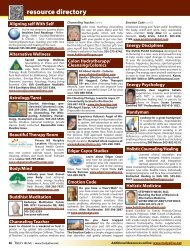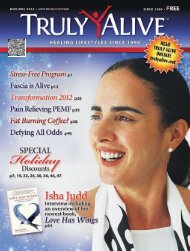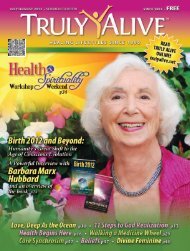Download - Truly Alive Magazine
Download - Truly Alive Magazine
Download - Truly Alive Magazine
You also want an ePaper? Increase the reach of your titles
YUMPU automatically turns print PDFs into web optimized ePapers that Google loves.
eport observes: “According to the Norwegian Dental<br />
Biomaterials Adverse Reaction Unit, the majority of cases<br />
of side-effects of dental filling materials are linked with<br />
dental amalgam.”<br />
• Alternative dental restoration<br />
materials are available. The<br />
report cites studies indicating that<br />
many alternatives are superior<br />
to amalgam, and states that<br />
“alternative restorative materials<br />
of sufficient quality are available<br />
for use in the deciduous [baby]<br />
dentition of children”—the<br />
population whose developing<br />
neurological systems are most<br />
susceptible to the neurotoxic effects of dental mercury.<br />
Perhaps more important than the survival of the filling,<br />
WHO asserts that: “Adhesive resin materials allow for less<br />
tooth destruction and, as a result, a longer survival of the<br />
tooth itself.”<br />
The WHO report also included mention of the known<br />
toxic effects of mercury exposure, stating: “Mercury is<br />
highly toxic and harmful to health. Approximately 80 percent<br />
of inhaled mercury vapor is absorbed in the blood through<br />
the lungs, causing damages to lungs, kidneys and the nervous,<br />
digestive, respiratory and immune systems. Health effects<br />
from excessive mercury exposure include tremors, impaired<br />
vision and hearing, paralysis, insomnia, emotional instability,<br />
developmental deficits during fetal development, and<br />
attention deficit and developmental delays during childhood.”<br />
popular alternatives to amalgam is resin composite, made of<br />
a type of plastic reinforced with powdered glass. It is already<br />
common throughout the U.S. and the rest of the developed<br />
world, offering notable improvements over amalgam, as it:<br />
• Is environmentally safe:<br />
Composite, which contains no<br />
mercury, does not pollute the<br />
environment. This saves taxpayers<br />
from paying the costs of cleaning<br />
up dental mercury pollution in our<br />
water, air, and land – and the costs<br />
of health problems associated with<br />
mercury pollution.<br />
• Preserves healthy tooth structure,<br />
because, unlike amalgam, it does not require the removal<br />
of significant amounts of healthy tooth matter. Over the<br />
long term, composite preserves healthy tooth structure<br />
and can actually strengthen teeth, leading to better oral<br />
health and less extensive dental work over the longterm.<br />
• Is long-lasting: While some claim that amalgam fillings<br />
last longer than composite fillings, the science reveals<br />
this claim to be baseless. The latest studies show that<br />
composite not only lasts as long as amalgam, but actually<br />
has a higher overall survival rate.<br />
Alternatives are Readily Available… and Desired by Most<br />
Americans:<br />
Far from being an essential dental product with no viable<br />
alternatives, amalgam is interchangeable with many other<br />
filling materials—including resin composites and glass<br />
ionomers—which have rendered amalgam completely<br />
unnecessary for any clinical situation. One of the most<br />
TRULY ALIVE in your INBOX...<br />
FREE Email Subscriptions<br />
505.828.3430<br />
www.trulyalive.net<br />
Email your<br />
request<br />
today!<br />
Read more articles by Bill Wolfe online: www.trulyalive.net<br />
<strong>Truly</strong> <strong>Alive</strong> | September/October 2012 23














